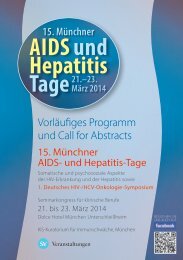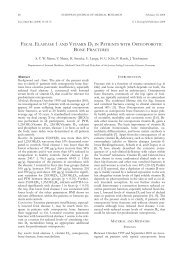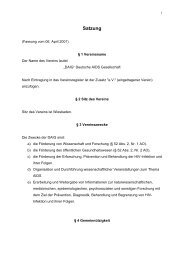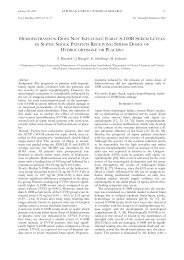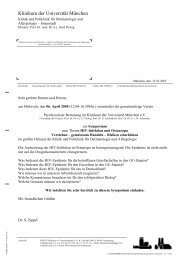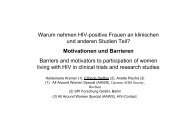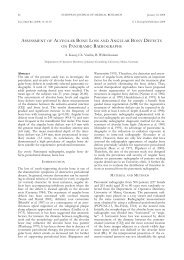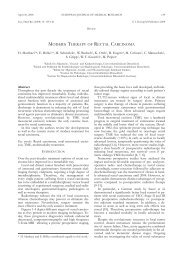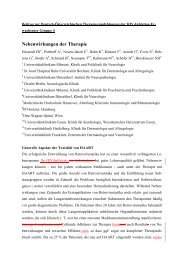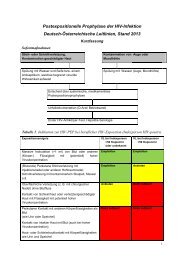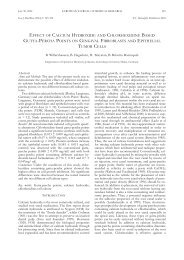European Journal of Medical Research - Deutsche AIDS ...
European Journal of Medical Research - Deutsche AIDS ...
European Journal of Medical Research - Deutsche AIDS ...
You also want an ePaper? Increase the reach of your titles
YUMPU automatically turns print PDFs into web optimized ePapers that Google loves.
106 EUROPEAN JOURNAL OF MEDICAL RESEARCH<br />
June 27, 2007<br />
Kaever, V. (2005) Quantification <strong>of</strong> antiretroviral drugs in dried<br />
blood spot samples by means <strong>of</strong> liquid chromatography/tandem<br />
mass spectrometry. Rapid Commun. Mass Spectrom. 19, 2995–<br />
3001<br />
D.68 (Vortrag)<br />
Antiretroviral therapy <strong>of</strong> patients infected with<br />
drug-resistant HIV-strains: Analysis <strong>of</strong> the<br />
composition <strong>of</strong> the first-line regimen in patients<br />
with a documented date <strong>of</strong> HIV-infection in<br />
Germany<br />
Poggensee G. 1 , Kücherer C. 2 , Werning J. 1 , Bartmeyer B. 1 ,<br />
Fleischhauer C. 1 , Braun P. 3 , Cordes C. 4 , Jessen H. 4 ,<br />
Klausen G. 4 , Schewe K. 5 , Stoll M. 6 , vanLunzen J. 7 ,<br />
Hamouda O. 8<br />
1 Robert Koch-Institute, Department <strong>of</strong> Infectious Disease and<br />
Epidemiology, Berlin, Germany, 2 Robert Koch-Institute, HIV-<br />
Variability and Molecular Epidemiology, Berlin, Germany,<br />
3 private practitioner, Aachen, Germany, 4 private practitioner,<br />
Berlin, Germany, 5 private practitioner, Hamburg, Germany,<br />
6 Hannover <strong>Medical</strong> School, Internal Medicine, Hannover,<br />
Germany, 7 University Clinic Hamburg Eppendorf, Hamburg,<br />
Germany, 8 Robert Koch-Institute, Department <strong>of</strong> Infectious<br />
Disease and Epidemiology and the German Seroconverter<br />
Study Group, Berlin, Germany<br />
Objectives: Studies <strong>of</strong> the first-line regimen in patients with<br />
transmitted drug resistance are limited. Aim <strong>of</strong> this study was<br />
to investigate the influence <strong>of</strong> genotypic resistance test results<br />
on the choice <strong>of</strong> first-line treatment in patients with a documented<br />
date <strong>of</strong> HIV-infection with transmitted drug-resistance.<br />
Methods: Genotypic resistance testing was performed in all<br />
drug-naïve patients <strong>of</strong> the HIV-seroconverter cohort. Data acquisition<br />
took place between 1998 and 2005.<br />
Start <strong>of</strong> antiretroviral therapy and drug composition <strong>of</strong> firstline<br />
treatment were assessed. Proportions were given with interquartile<br />
ranges. Mantel-Haenzels X2test and Fisher’s exact<br />
test were used. Viral loads and CD4 counts were compared by<br />
the Kruskall-Wallis test. p-values were two sided and p-values<br />
<strong>of</strong> < 0.05 were considered significant.<br />
Results: Of 922 tested patients drug resistant HIV was identified<br />
in 130 patients. Susceptible strains were found in 792<br />
individuals. Any NRTI resistant HIV was found in 25 individuals<br />
(25/35). NRTI resistance alone was detected in 21<br />
patients (21/35). Combinations <strong>of</strong> NRTI with PI and/or<br />
NNRTI resistance were found in 4 patients (4/25). PI or<br />
NNRTI resistance alone was assessed in 5 (5/35) and 4<br />
(4/35) patients, respectively. The remaining 5 patients<br />
showed different combinations <strong>of</strong> multi-drug resistance.<br />
Antiretroviral therapy was prescribed for 35 patients (35/130)<br />
with predicted drug resistant HIV. Treatment regimen <strong>of</strong><br />
25 patients (25/35) included at least one inactive drug. One<br />
inactive drug was included in the regimen <strong>of</strong> 17 individuals.<br />
The regimen <strong>of</strong> 5 patients comprised 2 inactive drugs. In 3<br />
patients no active drug was included in the first-line regimen.<br />
The majority <strong>of</strong> mutations conferred AZT-resistance<br />
(11/35). Since 2002 72% <strong>of</strong> first-line treatments included<br />
AZT (p=0.011). Since 2003 no PI or NNRTI were included<br />
in first-line treatments <strong>of</strong> patients with predicted PI/NNRTI<br />
resistance. AZT was not included in the regimen <strong>of</strong> three<br />
patients who were infected with highly AZT-resistant<br />
HIV. CD4-cell counts and viral load did not differ<br />
between individuals treated with or without compromised<br />
drugs.<br />
Conclusions: More recently a trend to omit compromised PI<br />
and NNRTI drugs appeared.<br />
Supported by BMG, BMBF/Competence Network HIV/<strong>AIDS</strong><br />
D.69 (Poster)<br />
Ritonavir-boosted fosamprenavir dramatically<br />
increased tacrolimus drug concentrations in an<br />
HIV/HCV-infected patient with liver<br />
transplantation<br />
Schulbin H. 1 , Masuhr A. 1 , Stocker H. 1 , Müller M. 1 ,<br />
Broelsch C. 2 , Beckebaum S. 2 , Cicinnati V. 2 , Arasteh K. 1<br />
1 Vivantes Auguste-Viktoria Klinikum, Berlin, Germany,<br />
2 Universitätsklinikum Essen, Essen, Germany<br />
Introduction: Drug drug interactions with ritonavir-boosted<br />
protease inhibitors (PI) are increasingly troublesome, as HIVinfected<br />
patients require treatment for other conditions than<br />
HIV.<br />
Methods: We describe the case <strong>of</strong> an HIV/HCV co-infected<br />
patient who initiated the immunosuppressant tacrolimus following<br />
liver transplantation.<br />
Results: The 36 year old male with HIV/HCV-coinfection<br />
underwent liver transplantation in December 2005 for chronic<br />
liver failure. Along with his stable antiretroviral therapy consisting<br />
<strong>of</strong> fosamprenavir/ritonavir 700/100 mg, twice daily<br />
and c<strong>of</strong>ormulated ten<strong>of</strong>ovir/emtricitabine he was started on<br />
tacrolimus 5 mg, twice daily. 5 Days after the start <strong>of</strong> this<br />
treatment the serum tacrolimus concentration was 65,4<br />
ng/mL, which is more than six times the desired value <strong>of</strong> 10<br />
ng/ml. Only after the dosage was reduced to 0,25 mg q 3 days<br />
stable drug trough concentrations within the required concentration<br />
range could be achieved. Serum amprenavir concentrations<br />
were also monitored but were within the normal range as<br />
compared to historical controls.<br />
Conclusions: Enhanced tacrolimus exposure in patients receiving<br />
c<strong>of</strong>ormulated lopinavir ritonavir has been described<br />
before. However, no prospective controlled pharmacokinetic<br />
studies have been performed. This is the first report on an interaction<br />
between ritonavir-boosted fosamprenavir and<br />
tacrolimus. As the numbers <strong>of</strong> HIV-infected patients with solid<br />
organ transplantation will rise clinicians must be increasingly<br />
aware <strong>of</strong> potential drug interactions with PI and immunosuppressants<br />
such as tacrolimus.<br />
D.70 (Poster)<br />
Low dose Prednisolone helps to delay HAART<br />
initiation<br />
Ulmer A. 1 , Müller M. 1 , Stützer H. 2 , Frietsch B. 1<br />
1 Praxis Ulmer Frietsch Müller, Stuttgart, Germany,<br />
2 University <strong>of</strong> Cologne, IMSIE - Institute <strong>of</strong> <strong>Medical</strong><br />
Statistics, Köln, Germany<br />
Objective: HAART is the best and almost the only established<br />
treatment option for HIV infected individuals. But it is<br />
expensive and complicated, leading to limited access in developing<br />
countries with dramatic consequences, connected with<br />
side effects and potential resistances. An important issue is to<br />
find additional or alternative therapeutic options and to increase<br />
the independence <strong>of</strong> HAART. The study groups <strong>of</strong> Andrieu<br />
and ourselves have already published a CD4-stabilizing<br />
effect <strong>of</strong> Prednisolone. The number <strong>of</strong> patients and the time <strong>of</strong>



